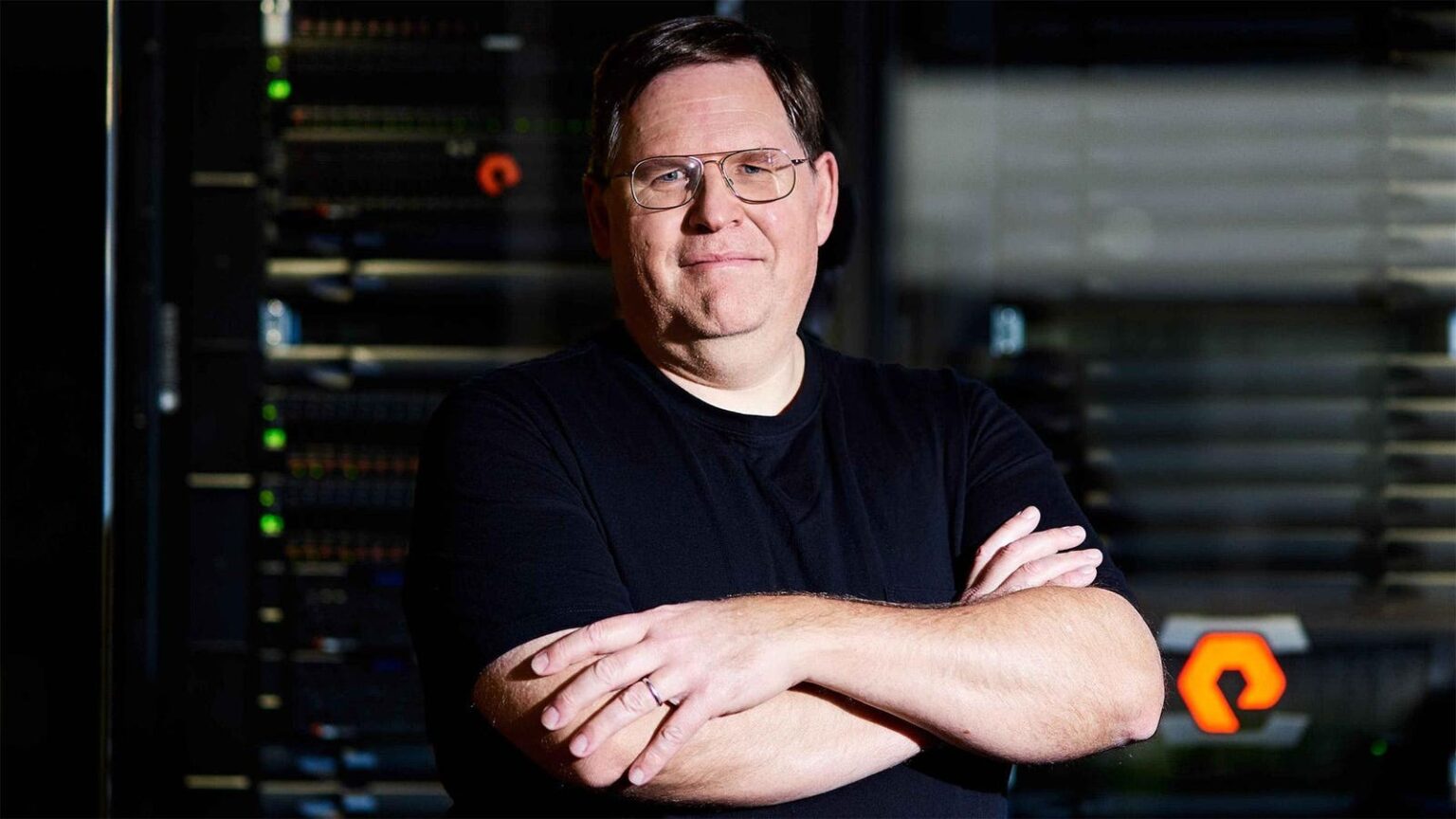Pure Storage’s low-key cofounder John Colgrove joins the three-comma club after signing a flashy deal with Meta amid increasing data storage demand.
John Colgrove—who still goes by his childhood nickname of Coz—dials in to a Zoom call from a hotel room in Vienna where he’s taking a brief respite ahead of meeting with Pure Storage’s European clients and speaking at conferences across London, Amsterdam, Paris and Munich. Despite being in vacation mode, the cofounder and “chief visionary officer” of the data storage company is wearing the same plain black T-shirt, gray basketball shorts and size 16 New Balance sneakers that he’s worn almost every day for decades. A creature of habit, the bespectacled 62-year-old explains that he has a strong disdain for even the slightest visible logos on his clothes, though he’ll sometimes vary the color of his shirt on the rare occasion he’s feeling adventurous.
Which begs the next obvious question: how is Colgrove, whose 4% of the $30 billion (market cap) Pure Storage is now worth around $1.2 billion, adjusting to his flashy new role of billionaire. When asked about it, Colgrove quickly retreats to banalities. “I’m focused on the fun and excitement of building a great company,” he emails back, adding flatly, “I appreciate the success Pure has had.”
You wouldn’t know it from his words, but it’s an exciting time for Colgrove and his company. Founded back in 2009 to capitalize on the emergence of flash drives, Pure Storage is having something of an annus mirabilis as the AI boom drives demand for fast, reliable data storage. Helped along by a deal to help Meta build its AI supercomputers—which Raymond James analyst Simon Leopold estimates could boost the company’s profits by up to $1 million in the coming year—Pure Storage’s stock is at record highs, up 70% in the last year. Revenue hit a record $3.2 billion last year, up 12%, and net income jumped 74% to $107 million in 2024.
Pure Storage’s growth is especially impressive given the relatively flat demand for data storage over the past few years. Globally, companies spent $33.5 billion on storage systems last year, up 2.5% from 2023 after spending fell in 2022, according to the International Data Corporation. But demand from AI-related spending is picking up. McKinsey estimates that AI demand will drive up to $800 billion in spending from companies on data storage alone in the next five years.
Flash memory, Pure Storage specialty, is two to three times more expensive than traditional hard drives, though companies may be inclined to spend more on the faster and more efficient flash technology, especially as they race to adopt and develop AI. “If you look at the long-term trend of flash technology versus hard drive technology, we’re near a crossover point right now and that’s going to flip, so that’s a gigantic opportunity that we have right now as a huge leader of flash,” Colgrove says.
Take modern navigation technology, for example: When you get in your car, an AI-powered phone or watch will estimate where it thinks you are headed and the best route to take based on your past driving history. The systems remembering and coming up with those estimates need quick, but accurate retrieval of historical data to execute properly.
For Colgrove, the current moment is the culmination of trends years in the making. When he founded Pure Storage sixteen years ago, the industry veteran was already convinced that flash drives would replace hard drives used by most companies at the time to store their data. And investors were sold on his conviction: Within its first five years, Pure Storage raised over $525 million in venture capital and boasted a $3.6 billion valuation before going public in October 2015.
Growing up in a small town in New Jersey as the youngest of three children, Colgrove says he was always buried in books and developed a knack for the sciences thanks to his father who was a research chemist. He discovered his love for computer programming through a high school accelerated math program, though he claims he wasn’t a good student. “I didn’t drop out, but I wasn’t far off from it,” he says, recalling that instead of attending class, he would spend his time working on personal coding projects. “I’m generally not a conformist.”
While working as a computer operator at Bell Labs after graduating with a computer science degree from Rutgers University, Colgrove landed a job interview in the Bay Area. “I was still living at home with my mom and thought to myself, ‘well, I’m going to still be living with her when I’m 50 if I don’t do something about it’,” he says. In 1987, Colgrove flew to San Jose and walked out into warm weather with the sun setting behind palm trees. Billboards dotting the California sprawl featured the hottest tech companies of the era. Captivated, he accepted a job as a software engineer at Amdahl Corporation and hauled his 78 boxes of books (mainly science fiction and history) and five boxes of “other stuff” 3,000 miles west.
Two years later, he joined data storage company Veritas Technologies as a founding engineer and was there through its IPO in 1993 and Symantec’s $13.5 billion acquisition of Veritas in 2005. By 2008, Coz was financially secure with a position as the chief technology officer at a division of the combined companies. At 46, he had already accomplished what many Silicon Valley “techies” dreamt of and figured it was time to retire. He did exactly that and spent the next year—and “several million dollars”—building a dream house in Los Altos. But planning and building the house made Colgrove quickly realize that his love for problem-solving wasn’t limited to computer code. “After I finished the house, I realized I wasn’t ready to be retired,” he says. “So I started looking for a startup to join, but couldn’t find anybody doing something that interesting.”
He joined Palo Alto-based venture capital firm Sutter Hill Ventures in 2009 as an entrepreneur-in-residence where he met his eventual cofounder John Hayes with whom he devised an idea around what he knew best: data storage. Adamant about staying in a technical role, Colgrove pushed for an outside CEO. An investor introduced him to Scott Dietzen, who had previously been CTO at multiple software startups, including BEA Systems (acquired by Oracle) and Zimbra (acquired by Yahoo). Dietzen ended up running Pure Storage as CEO from 2010 until 2017. (Pure Storage is now headed by CEO Charles Giancarlo whom Colgrove advises closely.)
From the very beginning, Pure Storage launched, in Dietzen’s words, a “full frontal assault” on the established players in the data storage industry, rather than settling for a smaller niche. The strategy proved successful: According to Louis Miscioscia, an executive director at Daiwa Capital Markets, Pure Storage is the sole survivor among over a dozen flash startups from that time largely because it went directly after EMC’s market share, even hiring a noticeable number of ex-EMC employees. EMC became the first major company in the data storage space to offer a flash-based product in 2009. In 2013, EMC sued 44 former EMC employees hired by Pure Storage, alleging the employees stole EMC’s intellectual property and confidential information. The lawsuit was settled three years later with Pure Storage, which had revenues of $728 million at the time, paying $30 million in a settlement to Dell, which had acquired EMC in September 2016 for $67 billion.
“The fundamental elements of Pure Storage’s business and technology are strong, but we would attribute their success mainly to strong execution in the legacy datacenter business, taking share from the likes of Dell EMC, HPE and NetApp,” says Jordan Nanos, member of technical staff at Semianalysis, an independent AI industry research company.
But now Pure Storage is a legacy player and a new generation of upstarts is duly taking aim at it. “We’re seeing the established (data storage) players start to adapt their marketing to AI workloads, but none of them so far have redone their products,” says Renen Hallak, who cofounded flash-based AI data infrastructure company VAST Data in 2016.
It’s hard to say with certainty if Pure Storage’s Meta deal is more sizzle than steak. It’s just a licensing deal, with Meta paying for the rights to use Pure Storage’s software and intellectual property to help the technology giant build its own storage solutions for its aggressive and ambitious AI infrastructure buildout. Because Pure Storage doesn’t have to make any hardware for Meta, it’s pretty much pure profit. But it also seems that Meta is no longer buying traditional data storage from Pure Storage. A source familiar with Meta’s AI research told Forbes that while Meta initially used Pure Storage to store its AI data around 2017, it has shifted to using another competitor in recent years. Meta and Pure Storage declined to comment on details of their past deals.
Still, Colgrove remains confident in Pure Storage’s products, strategy and more than 13,500 enterprise customers. “The one thing you can be sure of is that AI is developing so fast that what people need in a year, two years, three years will be radically different than today, so they need tremendous agility, and that is one of the things that we sell more than anything,” says Colgrove, who Dietzen claims “knows more about storage than probably any human on the planet.”
But equally the world is radically different than the one Pure Storage was born into 16 years ago. Flash storage alone won’t keep the company competitive. With a new generation of hungry competitors capitalizing on the AI boom, Pure Storage risks losing business. And Colgrove could even lose his new status as a billionaire—not that he would care.
Read the full article here














